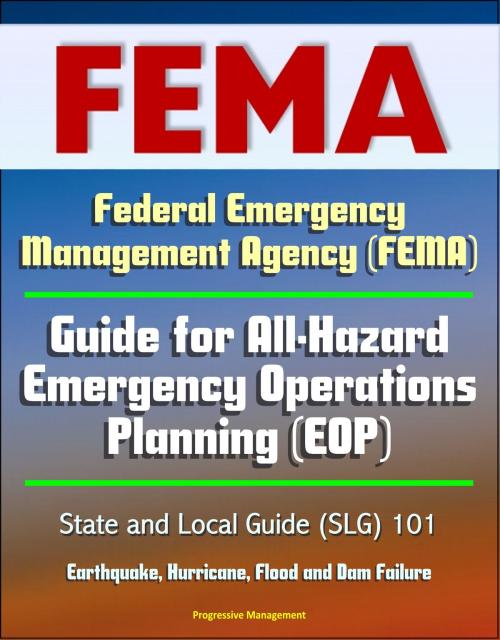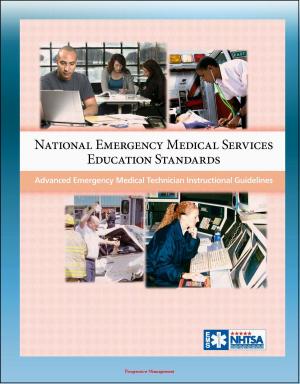Federal Emergency Management Agency (FEMA) Guide for All-Hazard Emergency Operations Planning (EOP) State and Local Guide (SLG) 101, Earthquake, Hurricane, Flood and Dam Failure
Nonfiction, Social & Cultural Studies, Social Science| Author: | Progressive Management | ISBN: | 9781310135545 |
| Publisher: | Progressive Management | Publication: | January 24, 2015 |
| Imprint: | Smashwords Edition | Language: | English |
| Author: | Progressive Management |
| ISBN: | 9781310135545 |
| Publisher: | Progressive Management |
| Publication: | January 24, 2015 |
| Imprint: | Smashwords Edition |
| Language: | English |
One goal of the Federal Emergency Management Agency (FEMA) is to develop, in partnership with State and local governments, a national emergency management system that is comprehensive, risk-based, and all-hazard in approach. Crucial to this system are emergency operations plans (EOP), which describe who will do what, as well as when, with what resources, and by what authority--before, during, and immediately after an emergency. This State and Local Guide (SLG) provides emergency managers and other emergency services personnel with information on FEMA's concept for developing risk-based, all-hazard emergency operations plans. This Guide clarifies the preparedness, response, and short-term recovery planning elements that warrant inclusion in State and local EOPs. It offers FEMA's best judgment and recommendations on how to deal with the entire planning process--from forming a planning team to writing the plan. It also encourages emergency managers to address all of the hazards that threaten their jurisdiction in a single EOP instead of relying on stand-alone plans. This Guide should help State and local emergency management organizations produce EOPs that: serve as the basis for effective response to any hazard that threatens the jurisdiction; facilitate integration of mitigation into response and recovery activities; and facilitate coordination with the Federal Government during catastrophic disaster situations that necessitate implementation of the Federal Response Plan (FRP). Emergency planners in the business and industry and animal care communities may find portions of this Guide useful in the development of their emergency response plans. Industry planners may also consult FEMA-141, Emergency Management Guide for Business and Industry.
Chapter 1 explains what an EOP is at the State and local levels, why the EOP is a necessary part of a comprehensive approach to emergency management, and how the EOP relates to other aspects of the comprehensive, risk-based, all-hazard approach.
Chapter 2 describes the approach FEMA recommends for a step-by-step process of risk-based, all-hazard emergency operations planning. Chapter 3 suggests how to format the results of the planning process in a written EOP. Chapters 4 and 5 list and discuss elements that, if applicable for a jurisdiction, should be addressed in its all-hazard EOP.
Chapter 6 notes unique aspects of certain hazards, including associated regulatory requirements. It suggests how to address these unique aspects in the all-hazard EOP rather than in stand-alone plans. The chapter is not meant to replace hazard-specific planning guidance issued by the Radiological Emergency Preparedness (REP) Program of FEMA and the Nuclear Regulatory Commission (NRC), the Chemical Stockpile Emergency Preparedness Program (CSEPP), or the National Response Team (NRT).
Chapter 7 contains information on integrating State EOPs with the Federal Response Plan, so that all levels of government can provide a coordinated response to communities in need.
Please note that, unlike previous FEMA planning guidance, this Guide addresses animal care and control and gives extensive treatment to resource management (including donations management).
One goal of the Federal Emergency Management Agency (FEMA) is to develop, in partnership with State and local governments, a national emergency management system that is comprehensive, risk-based, and all-hazard in approach. Crucial to this system are emergency operations plans (EOP), which describe who will do what, as well as when, with what resources, and by what authority--before, during, and immediately after an emergency. This State and Local Guide (SLG) provides emergency managers and other emergency services personnel with information on FEMA's concept for developing risk-based, all-hazard emergency operations plans. This Guide clarifies the preparedness, response, and short-term recovery planning elements that warrant inclusion in State and local EOPs. It offers FEMA's best judgment and recommendations on how to deal with the entire planning process--from forming a planning team to writing the plan. It also encourages emergency managers to address all of the hazards that threaten their jurisdiction in a single EOP instead of relying on stand-alone plans. This Guide should help State and local emergency management organizations produce EOPs that: serve as the basis for effective response to any hazard that threatens the jurisdiction; facilitate integration of mitigation into response and recovery activities; and facilitate coordination with the Federal Government during catastrophic disaster situations that necessitate implementation of the Federal Response Plan (FRP). Emergency planners in the business and industry and animal care communities may find portions of this Guide useful in the development of their emergency response plans. Industry planners may also consult FEMA-141, Emergency Management Guide for Business and Industry.
Chapter 1 explains what an EOP is at the State and local levels, why the EOP is a necessary part of a comprehensive approach to emergency management, and how the EOP relates to other aspects of the comprehensive, risk-based, all-hazard approach.
Chapter 2 describes the approach FEMA recommends for a step-by-step process of risk-based, all-hazard emergency operations planning. Chapter 3 suggests how to format the results of the planning process in a written EOP. Chapters 4 and 5 list and discuss elements that, if applicable for a jurisdiction, should be addressed in its all-hazard EOP.
Chapter 6 notes unique aspects of certain hazards, including associated regulatory requirements. It suggests how to address these unique aspects in the all-hazard EOP rather than in stand-alone plans. The chapter is not meant to replace hazard-specific planning guidance issued by the Radiological Emergency Preparedness (REP) Program of FEMA and the Nuclear Regulatory Commission (NRC), the Chemical Stockpile Emergency Preparedness Program (CSEPP), or the National Response Team (NRT).
Chapter 7 contains information on integrating State EOPs with the Federal Response Plan, so that all levels of government can provide a coordinated response to communities in need.
Please note that, unlike previous FEMA planning guidance, this Guide addresses animal care and control and gives extensive treatment to resource management (including donations management).















